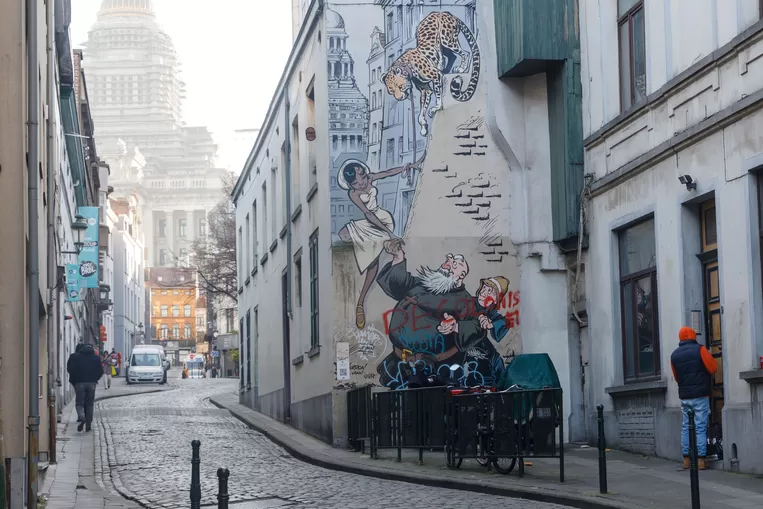A feminist collective criticizes the well -known cartoon drawings on the walls of Brussels. The city council refuses to remove them, but has a different solution.
Even more famous than Manneken Pis are the many colorful murals in Brussels. Anyone who has ever walked around the city cannot have escaped Belgian comic heroes such as Tintin, Lucky Luke or the Smurfs on the gray facades. The drawings belong to an official comic course, which originated in the nineties. The course is loved by tourists, who like to take photos and selfies at the walls. But not everyone is positive about the drawings.
For example, the route runs along the Palace of Justice, where a fresco covers four floors of a facade. On the drawing, two agents look for a colored man and a naked woman. A few hundred meters away, a drawing of the famous activist and jazz artist Josephine Baker hangs in a tight dress next to a cheetah. She is helped by two white fathers over a wall.
Thirteen Comic Walls Are “Offensive”
They are examples of murals that are “racist and sexist”, according to feminist collective Noms Peut-ffre. Three years ago the organization went to the municipality. At least thirteen of the total of 69 comic walls in the city of Brussels are offensive and have to disappear, according to the collective.
But the Brussels city council does not want to remove. Instead, all murals are provided with a QR code. If you scan that you get text and explanation about the drawing, says Arnaud Pinxteren, alderman for urban renewal.
“The comic walls are history. Sometimes they portray characters who were drawn in the 1950s. Of course the context has changed, so an explanation is needed. ” For the project, 40,000 euros has been invested and cooperation with the Brussels Comic Museum and researchers at the Brussels Studies Institute.
Strip author Wauter Mannaert understands that people think murals like those of Josephine Baker Baker. “If you walk there so much you see only a colonial image without context, that can happen weird.” Mannaert is also part of the official course with a comic wall over Yasmina, an 11-year-old bicultural girl from a poor family who can cook well. He came up with the character because from his past as a youth worker he was bothered that there were too few female main characters and few characters with a migration background.
In 2020, collective Noms Peut-être did an investigation into the comic walls, which showed that 85 percent of the heroes on the walls are men. In addition, the vast majority of the comic authors are male: 93 percent. The Brussels city council says it is aware of this: since 2018, eleven of the twelve new comic walls have been made by women or by a woman and a man, and also the number of female characters as a hero has increased, such as Yasmina.
“Important Context to Explain”
Émilie Plateau is one of the few female authors who is part of the course. “It’s a shame that the comic world is dominated by men,” she says. “Women now slowly get a stage more, that’s a good thing.” She understands the criticism of Noms Peut-ffre on traditional drawings. “The comics are made in a different time, it is important to explain that context.”
Comic author Mannaert also finds the discussion. Conscious or unconscious, sexism is interwoven in the comic world, he says. “I like to read my six -year -old son comics with animal facts. It is a pity that women invariably figure in sexy poses and in bikini, while the scientists are always men with ring beards. ”
But are the small QR codes a solution? Plateau: “It is a good way to conduct the discussion, but it only works if people actually take the trouble to scan the codes and read the texts.”
Alderman Pinxteren remains behind the codes. “I assume that people who find a comic wall will look for more text and explanation.” Fifty of the 69 comic walls now have a QR code. This year the remaining murals will also receive one.
This article is originally published on trouw.nl




